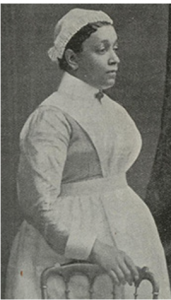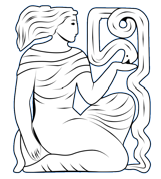| Author: Stephen Bourne
Independent Author |
The UKAHN Bulletin |
| Volume 9 (1) 2021 | |
Evidence for Black nurses in the UK, pre-1948
Evidence of the presence of nurses of Caribbean and African origin in the UK pre-1948 is thin on the ground but recent research is revealing more information. Stephen Bourne, the author of the following article, is one researcher whose efforts in this area are beginning to pay off. We reproduce below his recent biography of a Caribbean nurse, Annie Brewster, born in St Vincent but who nursed at the London Hospital from 1881 until her death.
The following article was first published in the Oxford Dictionary of National Biography (8 April 2021). It is reproduced here with permission of the publisher Oxford University Press and with permission of the Licensor (Oxford University Press) through PLSclear.
_______________________________________________________________________________
Brewster, Annie Catherine (1858-1902).
Author: Stephen Bourne
Oxford Dictionary of National Biography, published online 8 April 2021, https://doi.org/10.1093/odnb/9780198614128.013.90000380676

Annie Catherine Brewster (1858–1902), nurse, was born in St Vincent, British West Indies, in 1858, the daughter of Pharour Chaderton Brewster (1835–1920), a merchant who was recorded as being of black Barbadian birth (US federal census, 1910). In 1861 her younger sister, Laura, was also born in St Vicent. Sometime in the 1860s Pharour was widowed and he married Mary Belgrave in Barbados in 1866. The family then moved to England where, in 1871, they were living in Luton, Bedfordshire, as boarders of a farmer. Mary Brewster died in 1875 and in January 1879, at St Giles’s Church in Camberwell, Pharour married Angelina Impey, the widowed daughter of the farmer with whom they had boarded in Luton. The family had moved to London, where their home was at 2 Derby Villas, Grove Vale, Camberwell. In 1893 Pharour, Angelina, and Laura moved to the United States, where Pharour Brewster died in Nassau, Long Island, New York state, in 1920.
On 16 December 1881, aged twenty-three, Annie Brewster became a probationer nurse at the London Hospital in London’s East End. (Her appointment followed shortly after the death in London in May 1881 of the Jamaican ‘doctress’ Mary Seacole, one of the best-known black women of the Victorian era, though it is not known whether her example influenced Brewster to become a nurse). Eva Lückes, who gained a reputation as a progressive matron of the London Hospital and was evidently willing to recruit a black woman to her nursing staff, recorded that Brewster was:
a thoroughly satisfactory probationer, quick, thorough, intelligent and active. She was a favourite with all the sisters under whom she worked. She was equally well fitted for medical and surgical work and I was glad to accede to her request to be appointed staff nurse in women’s medical wards. She was gentle and kind to her patients and shewed a good ‘head’ for managing her ward.
(London Hospital Register of Probationers, Nov 1880–May 1884)
In 1890, after nine years’ service, Brewster defended the London Hospital when it was criticized for its poor treatment of nurses. Her letter, published in the Daily News (29 Aug 1890), refuted allegations of nurses having to undertake menial tasks, such as scrubbing tables, and poor food being given to them, and regretted that critics of the hospital had not made themselves ‘accurately acquainted with facts’ before making misleading public statements.
The last fourteen of Brewster’s twenty years’ service at the London Hospital were spent as nurse in charge of the ophthalmic wards. She became known as ‘Nurse Ophthalmic’ on account of her work with elderly patients who were going blind. Eva Lückes later described how, ‘with her quick intelligence’ Brewster ‘became very skillful in the treatment of “eyes” and her kindness to the poor old people who passed through her hands during this period was unwearied’ (The London Hospital Official Ward Book, 30 Nov 1901–24 May 1902). Latterly Brewster was in failing health and, following an operation, she died at the London Hospital, Whitechapel, on 11 February 1902, aged forty-three. She was buried in the City of London cemetery where the headstone on her grave was paid for by the London Hospital.
Annie Brewster’s achievements illustrate that there were black nurses employed in British hospitals before the foundation in 1948 of the National Health Service, when nurses were actively recruited from West Africa, British Guiana, and the Caribbean. However, as late as the 1930s, black women were not being recruited in many British hospitals, discrimination that was challenged on behalf of the League of Coloured Peoples by the Jamaican feminist Una Marson, though exceptions were made for women like Princess Tsehai, the daughter of Haile Selassie, the emperor of Ethiopia, who trained at London’s Great Ormond Street Hospital for Sick Children, and Princess Ademola, the daughter of the Alake of Abeokuta, the paramount chief of Northern Nigeria, who qualified at Guy’s Hospital.
Sources
‘Nurse Ophthalmic’, The London Hospital Gazette (June 1901–May 1902)
‘Annie Brewster, the London Hospital’s “Nurse Ophthalmic”’ (13 March 2017), East End Women’s Museum, www.eastendwomensmuseum.org <http:// www.eastendwomensmuseum.org>, accessed 2 Nov 2020.
- Bourne, War to Windrush—black women in Britain 1939–48 (Jacaranda Books, 2018).
- Johnston, ‘Paving the way to the NHS’, Southwark News (16 Aug 2018).
- Bourne, ‘A nurse who was favourite on ward’, South London Press (13 Sept 2019).
- Bourne, ‘Britain’s forgotten black nurses’, The Voice (12 Oct 2019).
- Eaton, ‘The Story of black nurses in the UK didn’t start with Windrush’, The Guardian 13 May 2020.
The London Hospital Register of Probationers (Nov 1880-1884), Royal London Hospital Archives.
The London Hospital Official Ward Book (30 Nov 1901-24 May 1902), Royal London Hospital Archives.
Census returns, 1871, 1881, 1891, 1901.
Death certificate.
